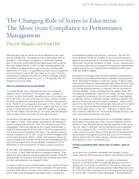This essay was written for the PIE Network 5th Annual Policy Summit, September 2011
State education agencies are being pushed to move from their historically passive role of monitoring compliance to a more active role in managing school performance. Events have coalesced to push for this transformation, including the 2001 NCLB Act, which requires SEAs to oversee performance at the school and district level. But in a politically charged environment with few additional resources, SEAs face considerable challenges in taking on this new role. A recent CRPE report points to federal restrictions on resource allocations as one of several obstacles standing in the way of SEAs assuming their new, active role.
This essay outlines the known factors constraining efforts to transform SEAs into performance managers (limited resources, short timeline, and rapidly changing parameters). The authors also ponder the unknown challenges, identifying gaps in the knowledge on how SEAs operate (resources, structures, and authority). To successfully take on the role of performance managers, states will need to identify critical points of leverage, repurpose limited resources, and secure the authority needed to drive change down to the school level. As the authors point out, it’s not clear what the successful SEA of the future will look like, but it is likely that the unsuccessful ones will be very similar to the SEAs of today.





